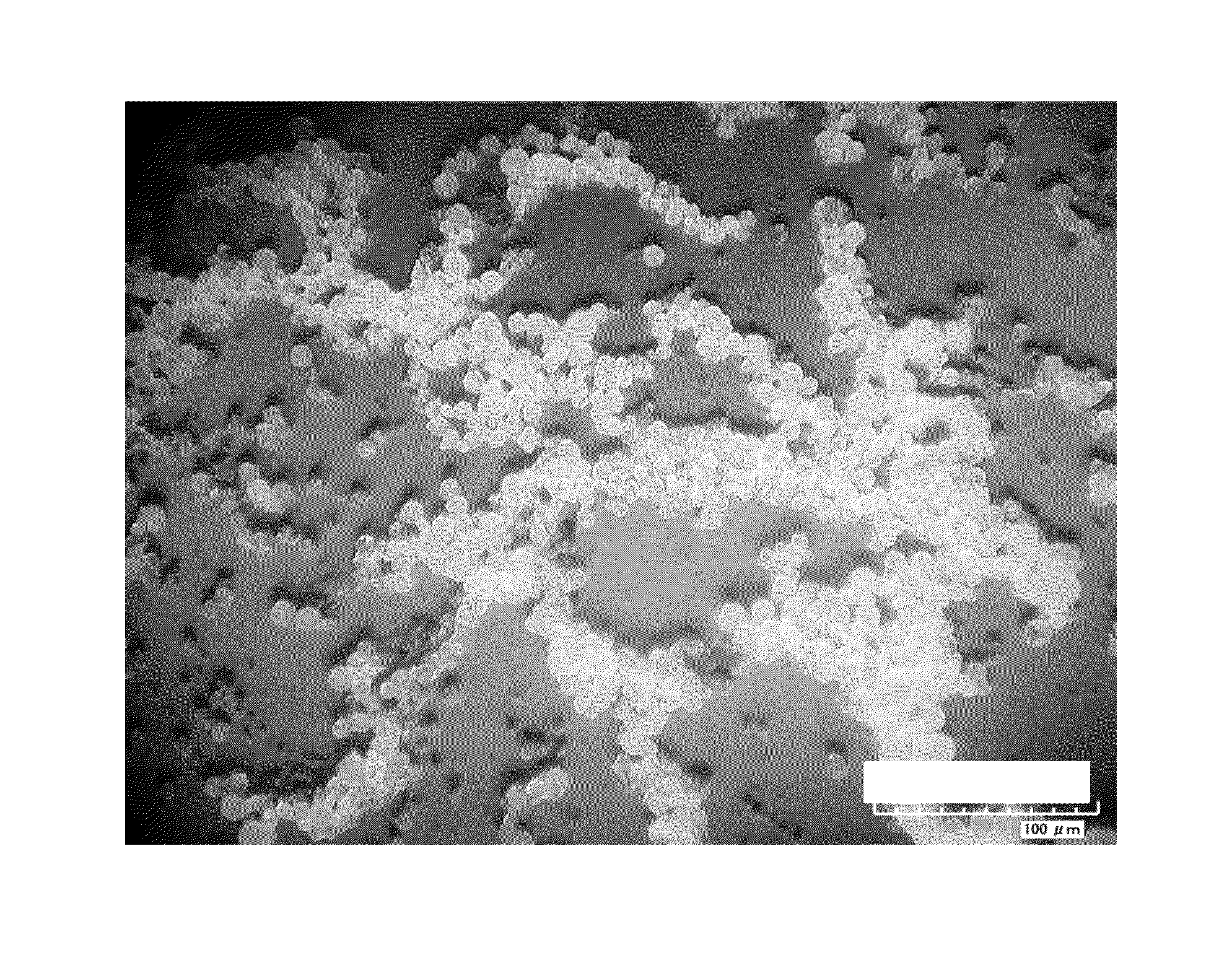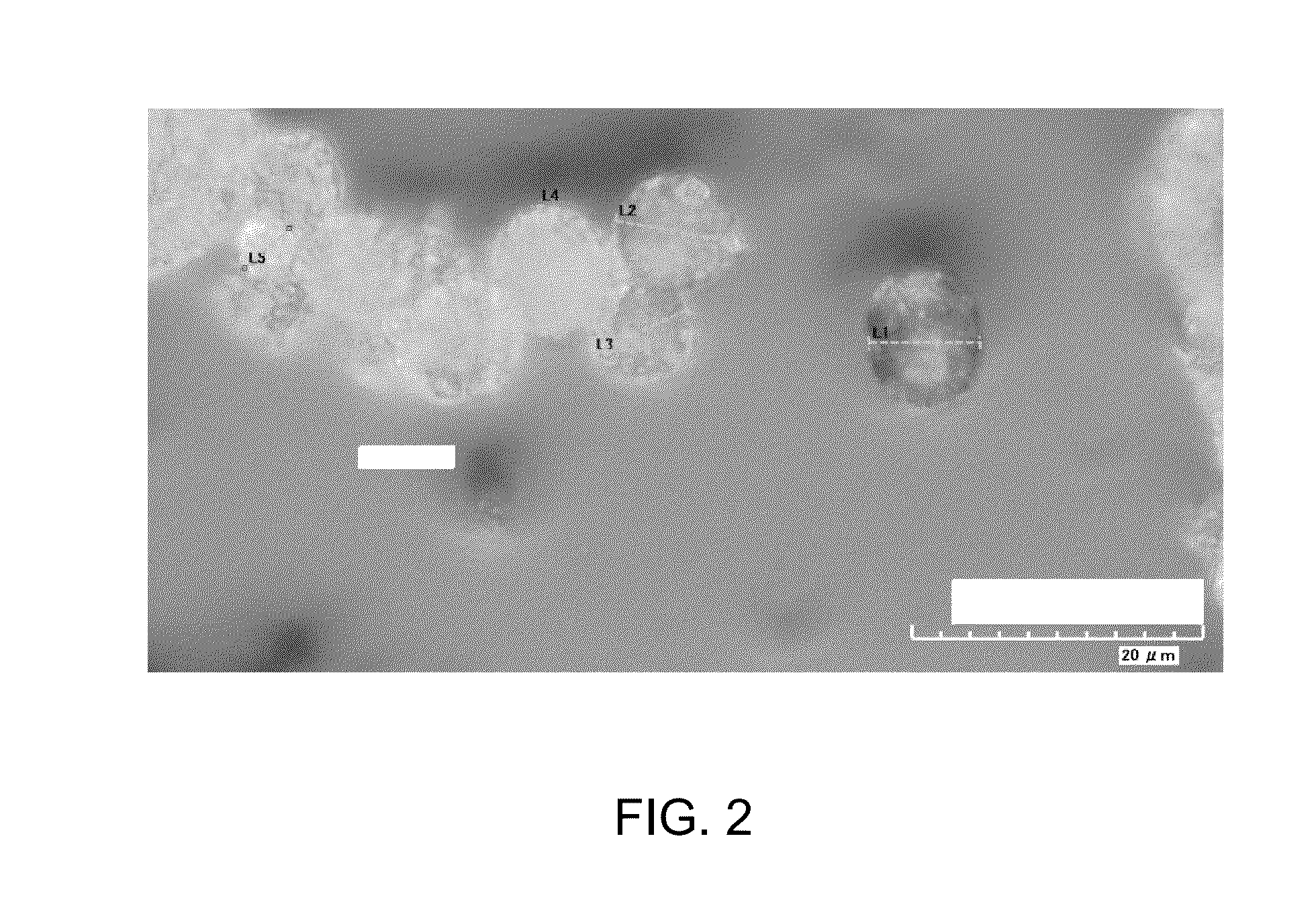Method for Reducing Marine Pollution Using Polyhydroxyalkanoate Microbeads
- Summary
- Abstract
- Description
- Claims
- Application Information
AI Technical Summary
Benefits of technology
Problems solved by technology
Method used
Image
Examples
example 1
Production of PHA Microbeads
[0077]Approximately 1 g of PHA pellets (obtained from Metabolix in Lowell, Mass.) was dissolved in 75 mL dichloromethane, and non-soluble particulates were removed by filtration. Approximately 10 mL of the PHA / dichloromethane solution was mixed with 30 mL of a 2% solution of methyl cellulose in water, and the mixture was homogenized for 3 minutes using a Virtis homogenizer. To the resulting emulsion was added 40 mL water, and the mixture was stirred for approximately 45 minutes to evaporate dichloromethane and produce PHA microbeads. The PHA microbeads were separated via centrifugation, then collected and dried. Representative images of the PHA microbeads, taken with a HIROX KH-7700 digital microscope, are shown in FIGS. 1-3. FIG. 1 shows a HIROX image of PHA microbeads at a magnification of 350×. FIG. 2 shows a HIROX image of PHA microbeads at a magnification of 2800×, and includes measurements of the diameter of selected PHA microbeads. FIG. 3 shows a H...
example 2
Formulation of PHA Microbeads
[0079]PHA microbeads can be incorporated into an exfoliating scrub as follows:[0080]Part A. 1. Propylene Glycol 30.00[0081]2. Glycerin, 30.00[0082]3. Methyl Gluceth-20, 33.30[0083]4. Acrylates / C10-30 Alkyl Acrylate Crosspolymer, Carbopol®* Ultrez 20 Polymer 1.00[0084]Part B. 5. Fragrance, 0.50 Fragrance[0085]6. PHA microbeads, 3.80[0086]7. Sodium Magnesium Aluminium Silicate, Liquibead 10PC Red D2, 0.50[0087]8. Euterpe Oleracea Pulp Powder, 0.10[0088]9. Phenoxyethanol (and) Ethylhexylglycerin, Euxyl® PE 9010, 0.80 Preservative
Procedure:
[0089]1. PART A: Mix Propylene Glycol, Glycerin and Methyl Gluceth-20 in a suitable mixing vessel.[0090]2. Disperse Carbopol®* Ultrez 20 Polymer by sprinkling on the surface of PART A with mixing (800-1,200 rpm). Mix until the polymer has completely dispersed, up to three hours.[0091]3. PART B: Add PART B ingredients to batch one at a time, in order with mixing at low speed. Mix batch until uniform.
example 3
Buoyancy Testing of PHA Microbeads
[0092]PHA powder was obtained from Shenzhen Ecomann Biotechnology Co. (Shenzhen, China), and sieved to provide PHA microbeads having the following size ranges: 0-45 microns, 45-100 microns, 100-180 microns, 180-250 microns, 250-297 microns, and 297-425 microns. These isolated PHA microbeads can be used in personal care formulations, and can also be combined, for example, combining two of the smaller fractions yields PHA microbeads having a particle size range of approximately 45 microns to 180 microns.
[0093]PHA pellets were obtained from Metabolix, and blended at high speeds to create microbeads having a low average circularity. The PHA microbeads were sieved to provide PHA microbeads having the following size ranges: 0-45 microns, 45-100 microns, 100-180 microns, 180-250 microns, 250-297 microns, and 297-425 microns.
[0094]The two sets of PHA microbeads (classified below as Ecomann and Mirel) were tested to determine how quickly the microbeads sank ...
PUM
| Property | Measurement | Unit |
|---|---|---|
| Fraction | aaaaa | aaaaa |
| Fraction | aaaaa | aaaaa |
| Fraction | aaaaa | aaaaa |
Abstract
Description
Claims
Application Information
 Login to View More
Login to View More - R&D
- Intellectual Property
- Life Sciences
- Materials
- Tech Scout
- Unparalleled Data Quality
- Higher Quality Content
- 60% Fewer Hallucinations
Browse by: Latest US Patents, China's latest patents, Technical Efficacy Thesaurus, Application Domain, Technology Topic, Popular Technical Reports.
© 2025 PatSnap. All rights reserved.Legal|Privacy policy|Modern Slavery Act Transparency Statement|Sitemap|About US| Contact US: help@patsnap.com



